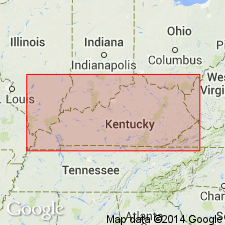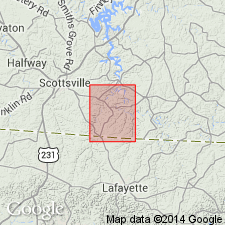
- Usage in publication:
-
- Cumberland sandstone
- Modifications:
-
- Named
- Dominant lithology:
-
- Sandstone
- AAPG geologic province:
-
- Cincinnati arch
Summary:
Probably named for Cumberland River. Is at top of Cincinnati group [Cincinnati series used as well] or Blue Limestone series. Consists of greenish, fine-grained sandstone. Thickness is 30 to 100 ft. Underlies so-called Clinton ore. Regarded as equivalent to Oneida conglomerate and Medina sandstone of NY.
Source: GNU records (USGS DDS-6; Reston GNULEX).

- Usage in publication:
-
- Cumberland Formation*
- Modifications:
-
- Revised
- Redescribed
- Dominant lithology:
-
- Dolomite
- AAPG geologic province:
-
- Cincinnati arch
Summary:
Cumberland Formation used in this report. Previously known as Cumberland sandstone. Dolomite, greenish gray, fine- to medium-grained; bedding regular and in part laminated and cross laminated; fossils rare.
Source: GNU records (USGS DDS-6; Reston GNULEX).
For more information, please contact Nancy Stamm, Geologic Names Committee Secretary.
Asterisk (*) indicates published by U.S. Geological Survey authors.
"No current usage" (†) implies that a name has been abandoned or has fallen into disuse. Former usage and, if known, replacement name given in parentheses ( ).
Slash (/) indicates name conflicts with nomenclatural guidelines (CSN, 1933; ACSN, 1961, 1970; NACSN, 1983, 2005, 2021). May be explained within brackets ([ ]).

